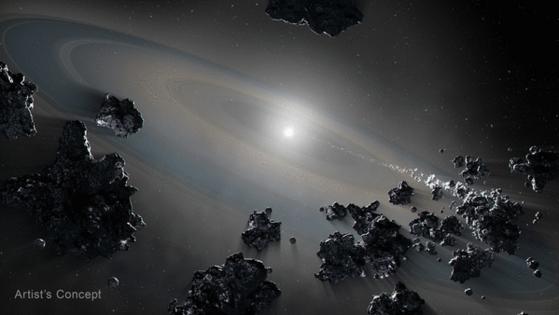Scientists find old white dwarf still munching rocks
Published in Science & Technology News
In an ancient star system expected to be stable and dormant, scientists found a 3 billion-year-old white dwarf star still tearing apart massive quantities of rock.
“The rate we’ve seen rock consumed by this star is very high,” said John Debes, an astronomer with the Space Telescope Science Institute in Baltimore and a co-investigator on a study published on October 22 in the Astrophysical Journal Letters.
A white dwarf is a star, similar to our own Sun, that exhausted all its fuel for nuclear fusion and collapsed into a sphere about the size of Earth. The Sun is expected to expand into a red giant in about 5 billion years, astronomers say, engulfing the inner planets up to Earth and Mars, before shrinking into a white dwarf. Even then, it will exert almost the same gravitational pull as it did before its collapse. Scientists believe that within the first billion years or so after the star collapses, most of the planets, asteroids, comets, dust and other debris within its inner orbits will be swallowed up.
“We don’t often detect dust in orbits around a white dwarf of this age,” Debes said. “They eat less and less over time, because fewer rocks remain within their reach. Something clearly disturbed this system long after the star’s death. There’s still a reservoir of material capable of polluting the white dwarf, even after billions of years.”
Scientists found 13 heavy chemical elements polluting the atmosphere of the star named LSPM J0207+3331, which is located about 145 light-years from Earth. They made their discovery using the W.M. Keck Observatory on Maunakea in Hawai’i by analyzing the colors of light from the star to assess which elements the light passed through. Analysis of the elements shows they must have come from a rocky body at least 120 miles wide.
“We don’t really know if these rocks being pulled in are big,” Debes said, “like the dwarf planets Ceres or Pluto in our solar system, or small things like asteroids or comets being perturbed in outer orbits and pulled in.”
In the process of being pulled in by their star, these rocks would be ripped apart by tidal forces, he said, creating the haze of elements seen in their observations.
Research on white dwarfs helps scientists better understand our own solar system and its future, Debes said.
The researchers plan to request time on NASA’s James Webb Space Telescope to try to image any cold planets that may still exist around this star.
“Future observations may help distinguish between a planetary shakeup or the gravitational effect of a stellar close encounter with the white dwarf,” Debes said.
_____
©2025 Baltimore Sun. Visit baltimoresun.com. Distributed by Tribune Content Agency, LLC.







Comments